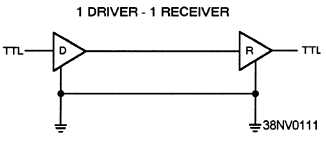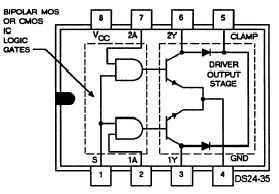variations and overtemperature conditions. Protection
circuitry to shut down the computer set before
component damage occurs is also included. Figure
4-33 shows an example of a comparator symbol.
TIMERS.— Timers use a basic comparator circuit
to drive a flip-flop. They can be used to produce a
circuit known as an astable multivibrator, which is used
to generate digital pulses of known widths and to
provide known time delays in digital circuits. These
timer circuits are used in the computer’s timing and
control section. See figure 4-34.
Systems Interface Circuits
Systems interface circuits amplify data signals
entering or leaving the computer. They act as a go
between, or interface that allows the various functional
areas or subsystems of a computer system to be coupled
together. The systems interface circuits of a computer
can be classified into the following areas: memory
drivers and sense amplifiers; peripheral and display
drivers; and line drivers and receivers.
MEMORY DRIVERS AND SENSE
AMPLIFIERS (DC AMPLIFIERS).— These circuits
serve as writing and reading units for magnetic
memories. Specifically they perform the following:
l Memory drivers —The memory drivers write
information into magnetic memories.
l Sense amplifiers —The sense amplifiers get the
data out. They sense when a core flips from a 0 to a 1
or vice versa. This reduces the chances of interference
from stray signal sources.
PERIPHERAL AND DISPLAY DRIVERS.—
These drivers are similar to memory and line drivers.
They drive digital information in computer, peripheral,
and display equipment. They do this by receiving a
small voltage and current digital signal(s) from bipolar,
MOS, or CMOS logic gate output and generating large
voltage or current output digital signal(s). Specifically
these circuits perform the following:
Peripheral drivers receive
l Peripheral drivers —
an input from bipolar or MOS logic gate output and
drive the output stage so that relatively large output
currents can be controlled with low-level logic signals.
Peripheral drivers use a single input and output
application. They are very useful for driving indicator
lamps or drive relays. See figure 4-35.
Display drivers use a multiple
l Display drivers —
input and output application. Three types of displays
Figure 4-35.—Example of a peripheral driver IC.
have drive requirements; they are the ac plasma
display, the electroluminescent (EL) display, and the
vacuum fluorescent (VF) display. Each of the three
display drivers requires high voltages but each has
unique voltage and current requirements.
LINE DRIVERS AND RECEIVERS. — Line
drivers and receivers are used in the transmission of
digital signals over both long and short distances. Line
drivers are used at the sending end and line receivers
are used at the receiving end. They are used in serial
and parallel applications for sending and receiving data
in I/O operations of the computer. There are two types
of line drivers and receivers as follows:
l Single-ended line drivers and receivers —
Single-ended line drivers and receivers (fig. 4-36) are
used for short distances. They have a single input and
output at both the transmitting and receiving end. They
are usually wire cables, possibly with an outer shield
connected to ground.
They are used for local
transmission to external equipments (including
computers) and for remote communications with
modems.
Figure 4-36.—Example of a single-ended line driver and
receiver.
4-21




